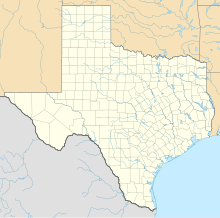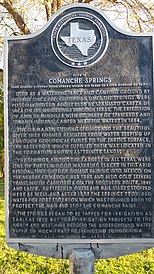Comanche Springs (Texas)
| Comanche Springs | |
|---|---|
 | |
 | |
| Name origin | Awache (Wide Water) |
| Location | Fort Stockton, Pecos County, Texas |
| Coordinates | 30°52′54″N 102°52′44″W / 30.88167°N 102.87889°W |
| Spring source | Edwards Aquifer |
| Elevation | 2,940 feet (896.1 m) |
| Type | Artesian aquifer |
| Provides water for | Rio Grande |
Comanche Springs was an aquifer of six artesian springs geographically located between the Edwards Plateau and the Trans-Pecos regions of West Texas.[1][2] The military fortification Camp Stockton was built around the springs, eventually growing become the city of Fort Stockton.
The groundwater source originated from a Comanchean limestone fault combined within the bountiful Edwards Aquifer and the Glass Mountains.[3][4] The natural spring has a physical geography routing north through Comanche Creek forming a confluence with Leon Creek and the Pecos River.[5] The alluvial river is a tributary to the Rio Grande.
History
[edit]Rio Grandé and Spanish expeditions
[edit]Comanche Springs served as an oasis with inhabitants dating to the Pre-Columbian era by the Jumano Indians.[6] Álvar Núñez Cabeza de Vaca scouted the Rio Grande region in 1536.[7] Fernando del Bosque explored the Rio Grandé area for Franciscans missionary districts in 1675 while Juan Domínguez de Mendoza lodged near the spring waters in the late 17th century.[8][9][10]
Forts and west frontier
[edit]On March 23, 1859, the Camp Stockton fortification was established in the Trans-Pecos region.[11][12] The garrison served as cantonment for the United States Cavalry warding off Plains Indians seeking to disrupt and raid the American pioneer, Butterfield Overland Mail, Concord stagecoach, covered wagon, Old San Antonio Road, Old Spanish Trail, San Antonio-El Paso Road, San Antonio–San Diego Mail Line, and wagon trains.[13][14][15][16][17]
Nomadic culture of Plains Indians
[edit]
The Apache, Comanche, and Kiowa visited the water basin frequently during bison and Colonial Spanish horse hunts, Comanche-Mexico War skirmishes, and Mexican Indian Wars in Northern Mexico.[18] The Comanche Trail permitted the nomadic migration of Native Americans to the West Texas desert climate during the northern hemisphere winter solstice.[19] The long-distance trail encompassed regional spring waters of Texas Big Bend Country given the horseback riding distance from the Staked Plains to Big Spring, Horsehead Crossing, Tunas Springs, Glenn Springs, San Vicente, Las Moras Springs, and Rio Grandé located within Big Bend National Park.
Irrigation of arid lands
[edit]Beginning in 1875, Comanche Springs was incorporated into an agricultural irrigation district resulting in the hydrological regression of the natural springs in the Chihuahuan Desert domain.[20] The Belding territory, located 11 miles (18 km) southwest of Comanche Springs, was a thriving agricultural development requiring voluminous water reserves.[21] The 6,000 acres (2,400 ha) to 7,000 acres (2,800 ha) irrigation demand lead to the overdrafting of the natural springs aquifer diminishing the Trans-Pecos water table.[22]
U.S. federal laws for arid lands irrigation
[edit]U.S. Congressional legislation for irrigation of the State of Texas arid lands.
| Date of Enactment | Public Law Number | U.S. Statute Citation | U.S. Legislative Bill | U.S. Presidential Administration |
|---|---|---|---|---|
| June 12, 1906 | P.L. 59-225 | 34 Stat. 259 | H.R. 14184 | Theodore Roosevelt |
| August 11, 1916 | P.L. 64-196 | 39 Stat. 506a | H.R. 12365 | Woodrow Wilson |
| October 6, 1917 | Public Resolution 65-14 | 40 Stat. 426 | S.J.Res. 89 | Woodrow Wilson |
| June 18, 1926 | P.L. 69-404 | 44 Stat. 753 | H.R. 3862 | Calvin Coolidge |
| May 28, 1928 | P.L. 70-556 | 45 Stat. 785 | H.R. 11471 | Calvin Coolidge |
| February 20, 1958 | P.L. 85-333 | 72 Stat. 17 | S.J.Res. 39 | Dwight Eisenhower |
Case law of Texas Rio Grandé and Trans-Pecos
[edit]- Text of United States v. Rio Grande Dam & Irrigation Co., 174 U.S. 690, (Supreme Court of United States 1899) is available from: Justia
- Text of United States v. Rio Grand Dam & Irrigation Co., 184 U.S. 416, (Supreme Court of United States 1902) is available from: Justia
- Text of Rio Grande Dam & Irrigation Co. v. United States, 215 U.S. 266, (Supreme Court of United States 1909) is available from: Justia
- Forest Reserve Act of 1891
Historical record
[edit]Comanche Springs received a Texas historic marker in 1968.[23]
Illustrations
[edit]See also
[edit]References
[edit]- ^ "Plateaus and Canyonlands". Texas Beyond History. University of Texas at Austin.
- ^ "Trans Pecos Mountains & Basins". Texas Beyond History. University of Texas at Austin.
- ^ "Edwards Aquifer Recharge Zone Geologic Map, South-Central Texas", U.S. Geological Survey, U.S. Department of the Interior
- ^ "Glass Mountains". TSHA Handbook of Texas Online. Texas State Historical Association.
- ^ U.S. Geological Survey Geographic Names Information System: Comanche Springs
- ^ "Who were the Jumano?". Texas Beyond History. University of Texas at Austin.
- ^ Chipman, Donald E. "Álvar Núñez Cabeza de Vaca". TSHA Handbook of Texas Online. Texas State Historical Association.
- ^ Chipman, Donald E. "Fernando del Bosque". TSHA Handbook of Texas Online. Texas State Historical Association.
- ^ Weddle, Robert S. "Juan Domínguez de Mendoza". TSHA Handbook of Texas Online. Texas State Historical Association.
- ^ "The Gateway Missions". Texas Beyond History. University of Texas at Austin.
- ^ "Frontier Federal Forts and Cattle Trails". Perry-Castañeda Library Map Collection. University of Texas at Austin. 1976.
- ^ "U.S. Army on the Texas Frontier". Texas Beyond History. University of Texas at Austin.
- ^ Richardson, Rupert N. (June 12, 2010). "Butterfield Overland Mail". Handbook of Texas Online. Texas State Historical Association.
- ^ "Old San Antonio Road". Handbook of Texas Online. Texas State Historical Association. June 15, 2010.
- ^ Fossey, Will (June 15, 2010). "Old Spanish Trail". Handbook of Texas Online. Texas State Historical Association.
- ^ Austerman, Wayne R. (June 15, 2010). "San Antonio-El Paso Mail". Handbook of Texas Online. Texas State Historical Association.
- ^ Stever, Rex H. (June 15, 2010). "Stagecoach Lines". Handbook of Texas Online. Texas State Historical Association.
- ^ Wallace, Ernest; Hoebel, E. Adamson (1952). "The Horse and The Buffalo". The Comanches: Lords of the South Plains. The Civilization of the American Indian. Vol. 34. Norman, Oklahoma: University of Oklahoma Press. pp. 33–66. ISBN 978-0806102498. OCLC 1175397.
- ^ Dial, Steve. "The Passing of the Indian Era". Texas Beyond History. University of Texas at Austin.
- ^ Kaiser, Ronald (July 2005). "Who Owns the Water?" [The State of Springs]. Texas Parks and Wildlife Magazine. Austin, Texas: Texas Parks and Wildlife Department.
- ^ Justice, Glenn. "Belding, Texas". Handbook of Texas Online. Texas State Historical Association.
- ^ Bloodworth, Morris E.; Gillett, Paul T. "Irrigation". Handbook of Texas Online. Texas State Historical Association.
- ^ "Site of Comanche Springs — Pecos County - Marker Number: 4757". Texas Historic Sites Atlas. Texas Historical Commission. 1968.
Historical video archive
[edit]External links
[edit]- Justice, Glenn. "Comanche Springs". Handbook of Texas Online. Texas State Historical Association.
- "Aquifers and Springs – Chapter 7". Texas Aquatic Science Partners.
- "Ethnobotany of the Lower Pecos Canyonlands". Texas Beyond History. University of Texas at Austin.
- "Explore Texas Geology". United States Geological Survey. U.S. Department of the Interior.
- "Major And Historical Springs of Texas - Report 189" (PDF). Austin, Texas: Texas Water Development Board. March 1975.
- "Simulation of Groundwater Flow in the Edwards-Trinity & Related Aquifers in the Pecos County Region, Texas" [Scientific Investigations Report 2013–5228] (PDF). U.S. Geological Survey. U.S. Department of the Interior. August 2014.
- "Texas Aquifers Study" (PDF). Austin, Texas: Texas Water Development Board. December 31, 2016.




